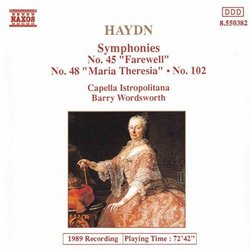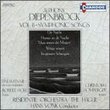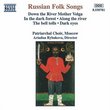| All Artists: Franz Joseph Haydn, Barry Wordsworth, Capella Istropolitana Title: Haydn: Symphonies Nos. 45, 48, 102 Members Wishing: 0 Total Copies: 0 Label: Naxos Original Release Date: 1/1/1990 Re-Release Date: 2/15/1994 Genre: Classical Styles: Historical Periods, Classical (c.1770-1830), Symphonies Number of Discs: 1 SwapaCD Credits: 1 UPCs: 730099538220, 4891030503823 |
Search - Franz Joseph Haydn, Barry Wordsworth, Capella Istropolitana :: Haydn: Symphonies Nos. 45, 48, 102
 | Franz Joseph Haydn, Barry Wordsworth, Capella Istropolitana Haydn: Symphonies Nos. 45, 48, 102 Genre: Classical
|
Larger Image |
CD DetailsSimilar CDs
|
CD ReviewsExploring the Haydn Symphonies: Nos. 45, 48, 102 Robin Friedman | Washington, D.C. United States | 08/16/2004 (5 out of 5 stars) "This CD is one of the earliest of the Naxos recordings of the complete Haydn symphonies dating from 1989. These early recordings featured Haydn's better-known symphonies, many of which have popular nicknames. Thus, this disc includes the "Farewell symphony" no. 45, the "Maria Theresia" symphony, , and the Symphony no. 102, one of Haydn's final "London" symphonies. The three works on this disk provide an excellent combination of Haydn's works. The CD allows the the listener to explore works from two distinct and important periods of Haydn's creative life. The symphonies no. 45 and 48 date from a period sometimes referred to as Haydn's "sturm und drang" period in which the composer experimented with a variety of forms and musical expressions and wrote with a passion that some new listeners find surprising. The symphony no. 102 dates from Haydn's final years of symphony composition in which he brought his writing to its highest level -- great music, indeed, and possibly still underestimated. The symphonies are performed here by a chamber orchestra known as the Capella Istropolitana under the direction of Barry Wordsworth. This group recorded the first fifteen or so of the Haydn series for Naxos. I have found the performances on the Naxos Haydn series well and idiomatically done. There is no better way to introduce the listener to Haydn's output and, by extension, to the love of music. The first symphony on this CD is one of Haydn's best known works and the only one of Haydn's early symphonies to retain a continued place in the repertory from Haydn's life until the present. The "Farewell" symphony, no. 45 in the unusual key of F-sharp minor was composed in 1772. There are many stories about the finale of this work -- which features each musician gradually walking offstage -- and this bold ending has tended to obscure some of the other features of this early symphony. Many students regard the "Farewell" as one of Haydn's greatest works. The "Farewell" opens with an angry, swirling and passionate movement marked "allegro assai". This movement is at least as inventive as the more famous finale. It features near the end of the development section the introduction of a new theme, of a slower and softer character than the remainder of the movement, prior to the return of the passionate outburst of the opening. This movement basically prepares the listener for the two contrasting parts of the final movement. The second movement is an adagio in the major key which contrasts with fiery character of the opening movement. The minuet theme is a brushing figure for the strings followed by a trio for the strings and horn. The famous finale is in two parts. The movement opens with a passionate outburst that harks back to the opening movement. Midway, the movement pivots to a slow almost dragging theme that is repeated around and around. It begins loudly and then gradually fades away is the musicians leave the stage in a not-so-subtle hint to thier Esterhazy patron that they are being overworked. This is an outstanding symphony. Haydn's "Maria Theresia" symphony in C major, no. 48 was composed for the Empress, but it is doubtful whether she ever heard it. The symphony is full of pomp and glitter. The first movement, allegro, is ceremonial and dazzling in its trumpet flourishes. The second movement, adagio, is contrasting, beautifully restrained, and quietly powerful with a large royal flourish at the end. It also features prominent brass passages for the horn. The minuet and trio are full of sparkle, trills, and ornaments with the horn again given an eminent role. The brief finale features a quick key change into the minor, interplay between the strings and winds, and an easy, carefree swing. Haydn composed his symphony no. 102 in 1794 for his second visit to London. This symphony was written for a large orchestra. It opens with a slow-curtain raising introduction which, following a transition passage for the solo flute, leads to a powerful opening allegro for strings and tympani. There is a leisurely, contrasting second theme. The second movement, adagio, is flowing, stately and graceful, and the movement develops gradually to one of some force and intensity. The minuet is one of Haydn's most famous in which the opening, angular theme is contrasted with a rounder, differently syncopated theme in the trio. The final is a quick rondo with a forward-moving theme. It begins quietly but soon opens up. It includes a couplet in the minor and some rambunctious moments in the conclusion. It is valuable to be able to spend time with this symphony alone, , rather than considering it simply as part of Haydn's final set of twelve. This CD offers an outstanding opportunity to begin an appreciation of the Haydn symphonies." A Haydn "Trio" J. De Sapio | Washington, DC | 07/21/2006 (5 out of 5 stars) "This CD is one of a long series on the Naxos label featuring Haydn symphonies; each disc in the series presents three symphonies from various parts of the composer's career. This particular release gathers together two examples of Haydn's middle-period STURM UND DRANG manner, Symphonies nos. 44 in F# minor ("Farewell") and 48 in C ("Maria Theresia"); and one of the late, great "London" symphonies, the Symphony no. 102 in B-flat. Symphony no. 48, the least-known, may have actually been written for a visit of Queen Maria Theresa of Austria-Hungary to the Esterhazy Palace; it is a brilliant, celebratory work featuring horns in high register. The magisterial Symphony no. 102 has one of Haydn's most deeply felt adagios and a presto to end all Haydn prestos; although its lack of a nickname has kept it from becoming better known, it is not inconceivable that this is Haydn's finest symphony. The Capella Istropolitana delivers relaxed, well-mannered chamber-orchestra interpretations of this repertoire. These are not the sort of weighty performances you would expect from a full-blown symphony orchestra like the London Philharmonic, but it is nevertheless an appropriate approach for Haydn.
" |

 Track Listings (12) - Disc #1
Track Listings (12) - Disc #1



